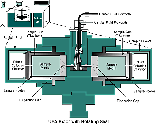


It took Conca a year to build the first UFA in 1988. It took even longer to secure funding and find a company that would agree to build a prototype. The UFA instrument was developed in a joint effort with Beckman Instruments, Inc. Beckman developed rotating seals for the UFA based on existing technology used to spin oil out of whole rock shales. Working through DOE's Office of Technology Development, a CRADA was put in place between Beckman and Pacific Northwest Laboratories that facilitated testing of the device and addressed all intellectual property rights. Beckman, a biomedical firm, provided prototype instruments for PNL use in developing a new product line in environmental restoration and management. Now Beckman is able to market the UFA including a new model developed to handle frozen soil samples. Three UFA units have been sold including one to Japan. There is interest in the apparatus from Australia, Canada, the Netherlands, Germany, and Britain. UFA was presented at a soil physics workshop held in Richland, Washington in March 1994 and at a 1994 symposium on new methods of measuring unsaturated flow at the Geological Society of America held in Seattle, Washington. NESTT (Northwest Environmental Services Testing and Training) has been formed to test materials for individual projects for those who do not want to purchase a UFA, but would benefit from its testing ability.
 The UFA
method is effective because it allows the operator to set the
variables in Darcys Law.A major benefit of this technology is
rapid, direct measurement of VOC (volatile organic compounds)
transport and improved predictive capabilities of VOC migration.
This in turn creates a greater probability of choosing successful
restoration strategies, improved remediation schedules, and a
reduced need in the future for lengthy experimental programs. The
alternative to the UFA method is dependence on less reliable
assumptions, (e.g., data based on wetter vadose zone conditions)
to extrapolate contaminant behavior. Soil samples are collected
using cable tool drilling/split spoon sampling technology. The
soil or bedrock samples are transferred to a specially designed
titanium canister and subjected to as much as 20,000
gravitational units in an open-flow centrifugation device. A
rotating seal assembly fitted to the canister allows an ultra-low
flow pump to deliver liquid or gas to the sample surface during
centripetal acceleration. When steady state conditions are
reached (within a matter of hours in most geologic materials),
effluent from the sample is collected and transport parameters
can be evaluated, e.g., hydraulic conductivity to measure
permeability, diffusion coefficient, and breakthrough
retardation. Data specific to remediation site sediments is then
compiled.
The UFA
method is effective because it allows the operator to set the
variables in Darcys Law.A major benefit of this technology is
rapid, direct measurement of VOC (volatile organic compounds)
transport and improved predictive capabilities of VOC migration.
This in turn creates a greater probability of choosing successful
restoration strategies, improved remediation schedules, and a
reduced need in the future for lengthy experimental programs. The
alternative to the UFA method is dependence on less reliable
assumptions, (e.g., data based on wetter vadose zone conditions)
to extrapolate contaminant behavior. Soil samples are collected
using cable tool drilling/split spoon sampling technology. The
soil or bedrock samples are transferred to a specially designed
titanium canister and subjected to as much as 20,000
gravitational units in an open-flow centrifugation device. A
rotating seal assembly fitted to the canister allows an ultra-low
flow pump to deliver liquid or gas to the sample surface during
centripetal acceleration. When steady state conditions are
reached (within a matter of hours in most geologic materials),
effluent from the sample is collected and transport parameters
can be evaluated, e.g., hydraulic conductivity to measure
permeability, diffusion coefficient, and breakthrough
retardation. Data specific to remediation site sediments is then
compiled.
The UFA method supports the development of restoration technologies such as vapor extraction or bioremediation for unsaturated soils. In addition, data obtained using the UFA can be used to confirm conceptual models predicting subsurface contaminant migration and to screen the performance of various remediation technologies in the field.
The Department of Energy has used UFA to measure the flow behavior of soils and sediments beneath the Z-plant at the Hanford site. Conditions there include completely saturated to highly unsaturated soils. Conca described the site as an old plutonium finishing plant where liquid waste had been put into unlined trenches. Waste included plutonium, americium, and carbon tetrachloride. To measure the flow behavior in this area, the prototype UFA was modified to accommodate VOCs and other nonaqueous phase liquids.
Several new characterization techniques have been developed based on UFA use at Hanford. Data gathered with the UFA method was used in combination with data on field moisture contents. The combined information was used to map artificial recharge in the subsurface associated with contaminant plumes and surface discharges to disposal cribs and trenches. The UFA method, together with borehole samples, was used to construct a detailed hydrostratigraphic map of the subsurface to help predict the transport and flow behavior of the soils beneath the Z-plant. This significantly strengthened the conceptual model of the site and knowledge of the contaminant plume migration.
![]()